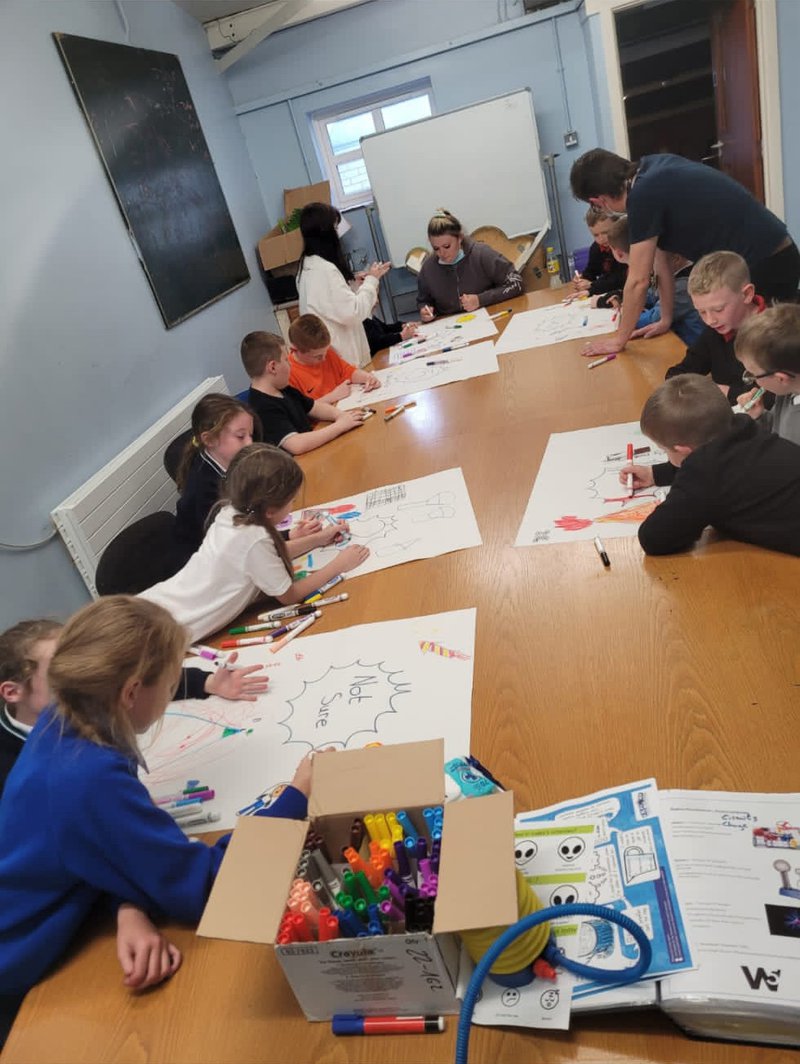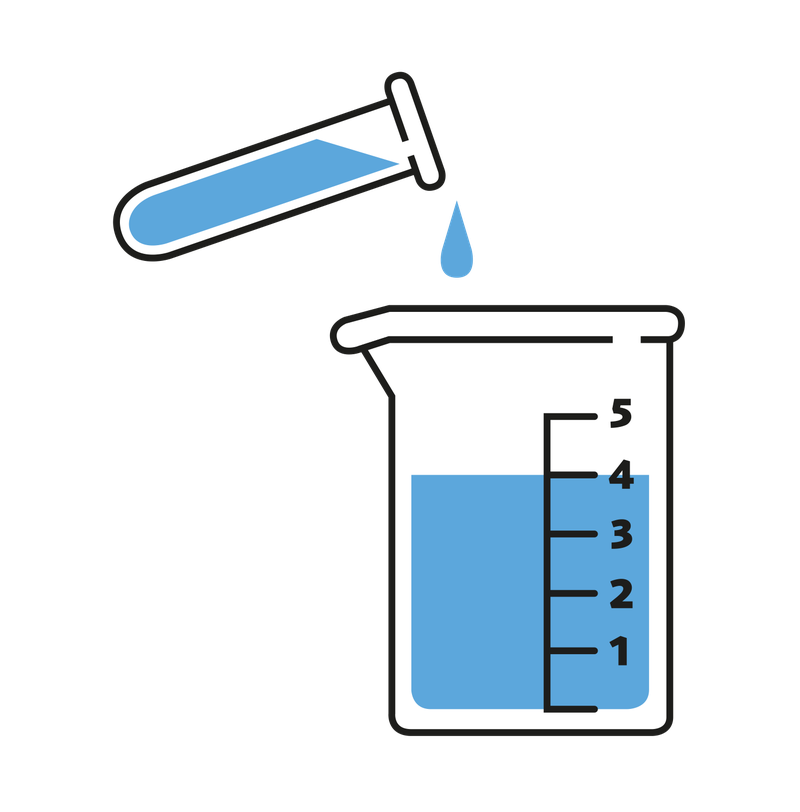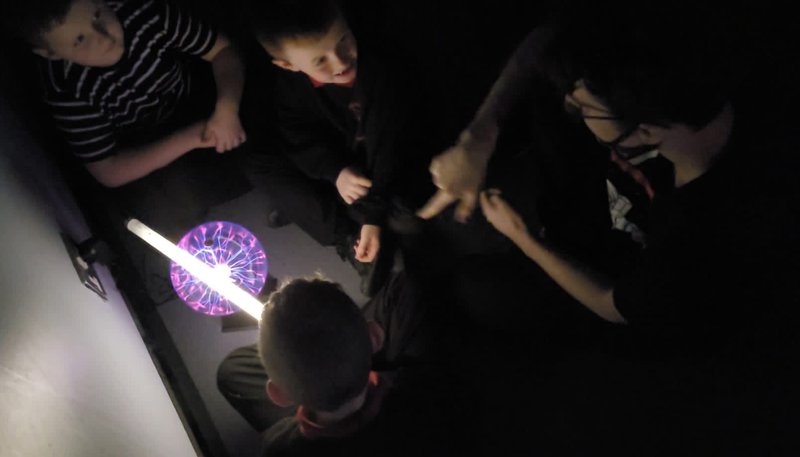Communities Creating Content
Ardoyne Afterschool’s Club working in partnership with W5
Who did you work with?
The organisation we worked with is called Ardoyne After Schools Club. Ardoyne makes up three areas ranking 4th, 9th and 16th on NIMDM (Northern Ireland Multiple Deprivation Measures). The club operate a pickup and drop-off service from the following schools; Holy Cross Boys/Girls, Bunscoil Bheann Mhadagain, Mercy Primary School, Our Lady’s Deanby and Sacred Heart, who have a high percentage of pupils from a Roman Catholic background. Damien Sparkes was the lead contact.
This was not the first community organisation to be involved in this phase of Explore Your Universe though. Originally, we had planned to work with the Ardoyne Youth Club. Other related organisations were also involved, North Belfast Advice Partnership and the Ardoyne Association but it became increasingly difficult to meet. At the close of the summer (end of August 2021) it became clear that we would need to find a new partner to work with during the school term, which was when we began working with the Ardoyne Afterschool’s Club. Delivery of sessions began with Ardoyne Afterschool’s Club on 23rd September 2021.

Had you worked together before?
No.
What goals, values or priorities did you share with your partner?
Ardoyne Afterschool's Club provide play opportunities aimed at meeting children’s social, physical, intellectual, creative and emotional developmental needs. They also enable parents to access training, employment and education. W5’s mission statement of ‘firing the spirit of discovery and unlocking the scientist and creativity in everyone’ aligns well. Both organisations are focused on the educational outcomes of the participants which meant we worked well together.
Can you summarise the aims of your project delivery in 2 (ish) sentences?
The aim of this phase of project delivery was to build upon the previous phase of EYU and create a reciprocal relationship with a community group through a co-designed, multiple engagement piece with young families. The chosen piece of work would be the content creation of the first science show to be delivered in the re-imagined W5 after re-opening in October 2021, and remain core programming moving forwards.

How co-produced was your programme?
- Information shared (the offer is decided and provided by you as the lead partner and people join to hear information)
- Consultation (the community partner/participants choose from a range of options, involving listening, feedback and discussion, but broader project objectives and delivery are led by you)
- Deciding together (community partners/participants support the creation and design phase, bringing new options and joint decision-making. Delivery and evaluation/reporting is led by you as the lead partner)
- Acting together (involvement of community partner/participant at each stage - from the planning and design, to the delivery and evaluation – with shared decision-making that forms a partnership to carry out the full programme)
- Supporting independent community interest (supporting partner agency, including offered funding, advice, and support to develop the independent ideas and agendas of the community partner).
We acted together with our community partner to encourage participating children to take ownership of the programme. With only three decision making sessions together, time for exploring alternative ways of working was restricted. This suited the group that we worked with as there were some children as young as 6 years old who had just finished a full day in school before each session. Deciding together on the content of the show was much more achievable in the timeframe allocated.
Can you note down some of the benefits and challenges to working this way?
The benefits to working through a decision-making process with students were clearly visible in the level of observed engagement and confidence with which the participants engaged. There were lots of opportunities to encourage personal development and mutual understanding, as well as addressing thinking skills and personal capabilities, which, although on the NI curriculum for this age, is not often the focus of activities that we create. Producing a product which is co-designed should also make the content more relevant to that audience and create a sense of ownership within that community.
During the first conversation with the community group co-ordinator, it became clear that there would not be any scope for selecting how many students we would be working with or reducing age range of the group, as part of the Club’s Covid-19 risk assessment had a strict ‘bubbling’ to reduce mixing of individuals within the centre and the pre-made groups would need to stay together. As a result, the group was larger and more diverse in age range than was originally envisaged.
When working with a group like this who were very young, there were challenges over how much direction the pupils are used to having over the direction of work. This was identified early, and a decision-making flow-chart was created to assist the creation of new material. In the end, the adults present talked the children through the flow chart as it was still too complex. The work was reduced from producing a full show to one demonstration, considering how much time was available.
One of the most difficult elements of the project was to encourage the community group that they had as much control over the direction of the project as we did. This was made harder during the most recent phase of Explore Your Universe as the community partner knew we had originally planned to work with another organisation first.
What was the science link?
The theme of ‘Electricity’ was pre-selected by the science centre as a jump off point for the group. Over the course of the sessions there was at least one element of demonstration by the science centre for the group to inspire and inform. These short demonstrations provided some context for the subject matter and encouraged conversation and discussion. Snap circuit kits, an electrostatic generator and plasma balls were the most effective tools at achieving this. These demonstrations also proved invaluable as hands-on learning tools when sharing scientific knowledge with the group.
What happened?
We had a desire to create a sense of ownership and pride in the creative content of a science show within W5, but also to promote a sense of belonging in the science centre. This sense of belonging would really only be measurable when the participants returned to W5 and reactions could be seen.
One story that shows this in action already is when a class from Holy Cross Boys’ Primary School were invited in to test out new exhibits installed as part of the Inspiring Science Project. On arrival, it was discovered that three of the class were participants in this phase of Explore Your Universe. The pupils themselves spotted the two members W5 staff who had been involved in delivering EYU and shouted to say hello. The pupils asked if they were going to see ‘their’ show. This was already an encouraging response.
The class did participate in the new electricity show, called ‘Free of Charge?’, which contained the plasma ball experiment the community group had worked on. During the show, the three boys from the After Schools Club offered lots of information about what they had looked at over the weeks together and chose to explain that electrons were negative but ‘not because they were grumpy; they have a charge.’
At the end of the show the audience were thanked for their participation, but a special thanks was given to Ardoyne Afterschool's Club, the co-creators of the show, and at that point a UV panel was turned on to reveal that the eight plasma balls on display during the show were signed in UV reactive ink by the co-creators themselves. When this happened the three EYU participants in the audience pointed out their own names on the plasma balls and a short discussion about ultra-violet light was had. This response displayed the genuine sense of ownership and pride we had hoped to promote during the programme.

Thanks for today Matthew and Amber, the children really enjoyed it and are looking forward to the next couple of weeks.
Leader at Ardoyne Afterschool’s Club
What challenges might lie in wait for someone wanting to replicate this project?
The largest challenge faced when trying to replicate this programme was that four sessions with participants is not enough for a co-creation project. Relationships were built over three sessions with the participants, but there were many more options to be explore in terms of content development.
Not having parents or carers involved in the programme due to Covid-19 restrictions was very unfortunate. When this project is replicated there needs to be some way to involve adults – essential to success. This was one of the strengths of a previous phase of EYU engagement.
Where there any surprises?
One of the biggest surprises during this phase of EYU is how quickly children absorb new vocabulary. There is very little fear in younger people in using the correct terminology for complicated concepts even when the concepts themselves may not be fully understood. Words like ‘electrons’, ‘plasma’ and even ‘charge’ were used by some of the participating six-year-olds when describing phenomena.
The group really enjoyed the icebreaker games called ‘circuits’ and ‘charge’ at the beginning of the first session so much that we returned to these each session as a reward for the participant's work.
We go to W5 every year and have really missed it. It’s great to see kids involved in live science shows.
Parent Helper from Holy Cross Boys’ Primary School
How did you capture/measure the impact for this project?
One big piece of learning that took place between the previous phase of EYU engagement and this one was the importance of a move away from formative evaluation towards a form that was more accessible to the audience. During a previous phase, each engagement session had participants completed a different type of data capture form. The number of tools used to evaluate was reduced in this project due to the number of weeks of engagement being shorter.
The evaluation tools that were most useful in measuring impact were the anti-form, which was answered with the use of a continuum. The question of how connected participants felt to science was answered using an adapted version of Science Oxford’s ‘emoji sheet’. The emoji sheet was answered using batteries and balloons as a voting system on the first and third session respectively.
The question of how inspired the participants felt after the sessions and what they would share with others about the session, along with their perceptions of science, were recorded visually through pictures on collaborative art pieces.
The reflection journals were a useful tool and the principles of reflective practice that were stimulated through conversation about the journals will be integrated into team planning in W5 going forwards.
The most valuable piece in terms of impact on evaluation was having access to Jen DeWitt. Having regular catch up meetings with Jen helped keep the evaluation of the project focused.
Where is the long-lasting change?
I believe that this project led to change three specific areas. Operationally, W5 will continue engaging with audiences directly through the co-created science show. Secondly, I believe that W5 has learned how interconnected community groups are, and how multiple community organisations may need to be involved for programmes to succeed in that environment. This is in contrast to how schools work, where one school contact is able to ensure participation and engagement.
The third area of change is around objectives. The fixed goals we have previously had to measure success of a programme may be too narrowly focused, and new ways of measuring success should be considered before commencement of any piece of work. Finding out more about the goals of the intended audience at the outset of a programme may be a more useful tool in measuring impact or worthiness of that programme. It would also help to make content more relevant and ensure the content serves the audience, rather than the other way around.